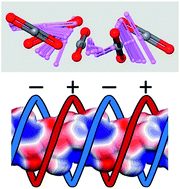A double helix of opposite charges to form channels with unique CO2 selectivity and dynamics†
Abstract
Porous molecular materials represent a new front in the endeavor to achieve high-performance sorptive properties and gas transport. Self-assembly of polyfunctional molecules containing multiple charges, namely, tetrahedral tetra-sulfonate anions and bifunctional linear cations, resulted in a permanently porous crystalline material exhibiting tailored sub-nanometer channels with double helices of electrostatic charges that governed the association and transport of CO2 molecules. The charged channels were consolidated by robust hydrogen bonds. Guest recognition by electrostatic interactions remind us of the role played by the dipolar helical channels in regulatory biological membranes. The systematic electrostatic sites provided the perfectly fitting loci of complementary charges in the channels that proved to be extremely selective with respect to N2 (S = 690), a benchmark in the field of porous molecular materials. The unique screwing dynamics of CO2 travelling along the ultramicropores with a step-wise reorientation mechanism was driven by specific host–guest interactions encountered along the helical track. The unusual dynamics with a single-file transport rate of more than 106 steps per second and an energy barrier for the jump to the next site as low as 2.9 kcal mol−1 was revealed unconventionally by complementing in situ13C NMR anisotropic line-shape analysis with DFT modelling of CO2 diffusing in the crystal channels. The peculiar sorption performances and the extraordinary thermal stability up to 450 °C, combined with the ease of preparation and regeneration, highlight the perspective of applying these materials for selective removal of CO2 from other gases.

- This article is part of the themed collections: Most popular 2018-2019 main group, inorganic and organometallic chemistry articles and Functional Organic Materials Symposium Collection


 Please wait while we load your content...
Please wait while we load your content...